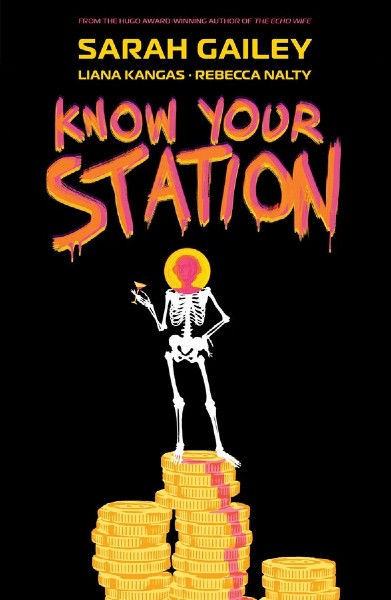Space Mysteries Meet Class War: The Thrills of “Know Your Station”

I’ve been reading comic books for a significant chunk of my life now. Given that I’m in my forties, that’s a lot of years - and there are times when I have to remind myself that something that might initially seem to me to be an unexpected motif isn’t actually one. Case in point: writers who I primarily know from their work in prose making a foray into comics isn’t actually that odd at this point. It might have been when I learned of Samuel R. Delany’s stint writing Wonder Woman in the 1970s or Rachel Pollack following Grant Morrison on Doom Patrol; it’s not now, in 2023.
Still, one of the things that drew me to Know Your Station, from writer Sarah Gailey and artist Liana Kangas, was my familiarity with Gailey’s writing. I’ve been reading their fiction for a while, including the terrific novel Magic for Liars, and their newsletter Stone Soup is both a fantastic read and has pointed me in the direction of some other notable writers. As for Kangas, I enjoyed their work on the offbeat occult crime story True Kvlt quite a lot — which meant that Know Your Station appealed to me before I’d even read a page of it.

So: there are a couple of different things going on in Know Your Station that I like. The first is that it falls into an especially compelling overlap of genres, to wit: it’s a locked room mystery set in space. (See also: Tade Thompson’s Far From the Light of Heaven.) And if that was all that this was — a book about an unlikely investigator solving a mystery in the cosmos — it would be impressive enough. But that’s not all that’s taking place here; like a lot of the best mystery fiction, it’s also a book about class — something that’s not a huge shock, given that Gailey’s previous creator-owned graphic novel was called Eat the Rich.
That book’s title had a double meaning (hint: the plot involved cannibalism as well as class consciousness). Not surprisingly, Know Your Station also has a double meaning: literal knowledge of a space station is crucial to the plot, but the story also abounds with obscenely wealthy characters who urge our heroes to, well — you can probably figure it out.
Elise, the story’s protagonist, works on the First Resort as the station’s security liaison; narration early in the book from St Brigid, the AI that operates the station, states that she “is responsible for smooth communication and coordination between staff and residents of the First Resort.” That sounds great in theory; in practice, that means that Elise is the point of contact between the callous rich and the resentful working class — and it isn’t shocking that, at the time the graphic novel opens, she’s addicted to a hallucinatory drug called Blue. There’s a nice bit of shorthand early on that the First Resort’s passengers do not represent, shall we say, the most humanistic perspective when one of them laments the loss of a valuable piece of jewelry — one that contains part of the wreckage from the space shuttle Challenger. If that reads as more ghoulish than anything else on the part of this character, you’re on the right track.
St Brigid, whose rapport with Elise is alternately all-knowing, somewhat flirtatious and often cynical, is a joy to read, whether in the form of a disembodied form or the outline of a human-shaped figure, albeit translucent. (Colorist Rebecca Nalty and letterer Cardinal Rae have plenty of opportunities to show off their skills here, whether it’s through using a different approach to lettering encrypted communications or accentuating Elise’s hallucinatory fugues and starkly-lit murder scenes.
Oh right: there are murders on the First Resort. A detective, Leona Pritchard, shows up to work with Elise investigating one — and, soon enough, there are more bodies to investigate, and Elise finds herself in way over her head. (The presence in the mix of a hallucinogen further complicates matters.) The bodies are displayed in a suitably Grand Guignol manner; between this and the design work Kangas displays on the First Resort’s uniforms, the look and feel of the ship, and the shifts from industrial sterility into visceral moments of horror, makes for a fine artistic showcase.
Gailey’s script, too, does plenty. As mentioned earlier, this book would be a perfectly engrossing read if it was simply a straightforward whodunit set in the future — and it certainly checks off all of those boxes. (The point where it became clear just who was responsible for the killings made me do a double take before I realized how clever the solution was.) But this isn’t just a whodunit; Gailey has paid attention to the social dynamics of a space like the First Resort, and the ways in which the entitled rich can behave. The dynamics between Elise and fellow crew member Marin — which shift from solidarity to suspicion and back again over the course of the narrative — are also revealing about both characters and their shared history.
Know Your Station is a memorable science fiction mystery, to be sure — but this story has a lot more to offer, and it features all of the artists involved doing top-notch work. Which, given the themes found in this book, seems entirely in keeping with its spirit.